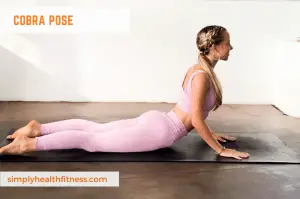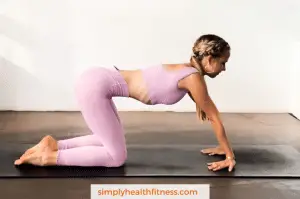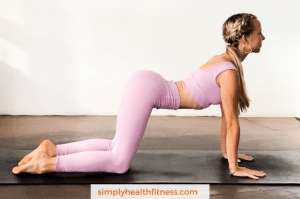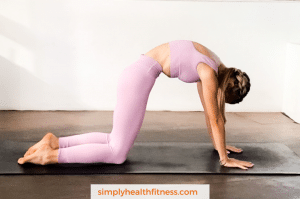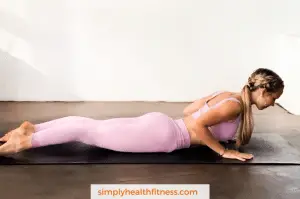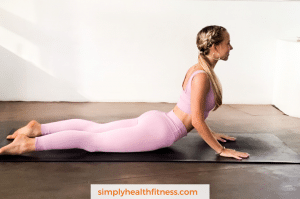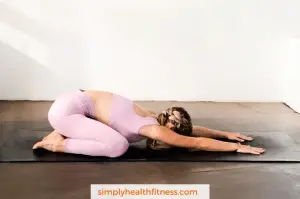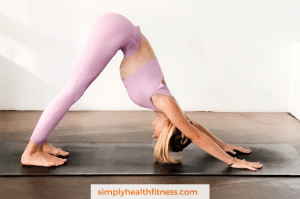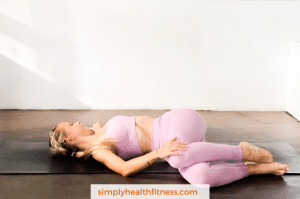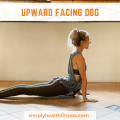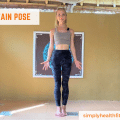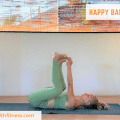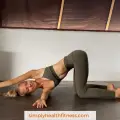The cobra pose in yoga is one of the most famous poses in the yoga world. More traditionally named after the serpent, in Sanskrit, it is called “Bhujangasana” (boo-jang-GAHS-anna).
When you break it down, it combines “bhujanga,” meaning snake, and “asana,” meaning pose or posture. Seeing it performed makes sense of the name, as it reminds us of the cobra raising its hood.
The cobra pose is a variant of a pose we perform in the series of traditional sun salutations (“Surya Namaskar”), most commonly known as “upward facing dog (“Urdhva Mukha Svanasana”).
The sun salutation is a practice that warms up the body and prepares us for our practice. It is done to show gratitude to the sun, earth, and ourselves; hence the name “Surya Namaskar,” with “namaskar” meaning “bowing and offering oneself in gratitude” and “Surya” meaning “the illuminator.”
Cobra poses are a great way to start practicing backbends and improving the flexibility of your spine. The following article discusses why it’s important to work on these poses, as well as providing step-by-step instructions for performing the cobra pose.
The Cobra Pose in Yoga – A Step by Step Guide
Warm-up
Before attempting to do any pose in yoga, it is always recommended to be properly warmed up in order to prevent injuries and ensure proper form.
1. From a seated position, begin to roll your neck in small semi-circles. Begin by taking your head down to stretch the back of the neck. Once you have performed a few rounds of gentle rolls forward, then take your semi-circles to the back, dropping the head as far as is comfortable without compressing the back of the neck.
2. After the neck is warm, roll your shoulders forwards and backward. Start out small and work your way to bigger circles to increase the range of movement.
3. Come into a table top position, with your palms under your shoulders and knees under the hips. From here you can take a few stretches for the wrist joint. You can play with the position of your hands and/or the distribution of your weight by rocking back and forth and side to side.
4. Perform a few cycles of “Cat and Cow”
For cow pose, inhale as you draw your chest up, drop the belly, and arch the back.
For cat pose, exhale as you curl your shoulders and spine upwards, tuck the belly in, and drop the head.
After few rounds of this, linking your breath to movement, you increase your blood flow and prepare the chest and hips for the cobra pose.
Cobra Pose
1. Start by lying on your stomach, preferably on a mat or towel. Place your palms under your shoulders, with your elbows bent and tucked into your body. Your feet are at hip-distance apart and pointed, with the tops facing down.
2. On the inhale, slowly and carefully peel your chest off the floor while engaging your glutes, back muscles, and triceps. Listen to your lower back and only press up as far as it is comfortable.
3. Make sure your shoulders are pulling away from your ears and pressing back in order to open your chest. Your palms and fingers should have an equal weight distribution to protect your wrist joint. Your gaze should be forward so that your neck is not compressed.
4. Keep your lower body glued to the mat by pressing your pelvis, thighs, and tops of your feet to the floor.
5. If your lower back is healthy and is not in pain, you can enter the full cobra by extending your elbows more, but still keeping a slight micro-bend. There should be a diagonal line from your wrists to shoulders, as your hands are slightly in front of you.
6. Hold this pose in its final position for no more than 5 breaths before releasing and taking a short rest. Only repeat the pose if your lower back is healthy.
Have a look at my tutorial video if you want to learn more about the Cobra Pose:
Counter Stretches
When you are done practicing this pose, take a few counter poses in order to decompress your lower spine and shoulders. Hold these poses for 5-10 breaths.
Child’s pose
Stretch your arms in front of you and sit your hips back into your heels with your knees either hip-distance apart or together.
Downward facing dog
Press palms and fingers to the floor and raise your hips up to lengthen your spine and stretch the backs of your legs. Depending on your flexibility, the heals may or may not reach the floor.
Lying spinal twist
Lie on your back as you hug your knees in and take them to one side to feel the twist. Repeat on the other side.
Deepen the Pose
If you have been practicing for a while, your spine should be strong and flexible enough to make more advanced variations of this pose.
After a few weeks or months of practicing, your spine should be strong and flexible enough to take it further into full cobra pose.
Sphinx Pose (“Salamba Bhuangasana”)
Sphinx pose is similar to the cobra pose, except your weight is on your elbows. Instead of placing your palms under your shoulders, place your elbows under your shoulders, with the palms and forearms pressing to the floor in front of you.
With your back muscles and glutes engaged, you can peel your upper body off the floor and straighten your arms for a deeper bend.
Upward Facing Dog (“Urdhva Mukha Svanasana”)
Place your palms closer to your body than you would in the cobra pose and when you lift the upper body, also lift your pelvis and lower body off the floor by pressing the tops of your feet and palms.
This pose is in the sun salutation sequence and uses more arm strength as well as the quadriceps.
Risks and Common Mistakes to Avoid
Our bodies are all different and, therefore, it is important to take caution with any pose you attempt.
Avoid this pose if you suffer from any injuries related to your wrist or back. Furthermore, take extra care if you are pregnant, as it is a pose that puts weight on the stomach. If you are past the first trimester, these poses are more uncomfortable, so I would recommend placing a bolster or pillow under your pelvis or use a variation that is on the hands and knees (such as the cat and cow poses).
Common mistakes to avoid are over-arching the neck and spine. By over-arching, you are compressing these areas and putting pressure on the joints rather than using the muscles. Keep the strength and work in the back muscles, core, and shoulders in order to protect yourself from injury.
Key Benefits
Physical Benefits
One of the most renowned yoga teachers of our time, BKS Iyengar, noted that the cobra pose provides therapeutic benefits to those with back issues.
Backbends, in general, offer a range of benefits depending on what your body needs. Working on the strength and flexibility of your back muscles and joints helps protect our organs, nerves, ligaments, and tendons while we move in different planes.
This protection also gives us a better range of mobility in everyday activities and improves our posture. With our lives being increasingly spent in front of screens, opening the chest can help fight the shoulders’ tendencies to always crunch forward.
Spiritual Benefits
On a more spiritual level, the cobra pose and other backbends alike allow us to open up certain energy blocks in our bodies. The seven main energy systems in our body, called chakras, are linked to our body systems as well as the energies that dominate our thoughts and feelings.
Being aware of our chakras can help us find certain energy blocks and help us towards finding balance. One of the ways you can work on a blocked chakra is with yoga.
The cobra pose can help you with the heart chakra (also known as the Anahata chakra) as well as the solar plexus chakra (the Manipura chakra).
Tying in on what BKS Iyengar claimed about the benefits of heart-opening for those who are suffering from stress and fatigue, can be linked to our heart chakra. When blocked, the heart chakra can make you withdraw from the world and be numb. When you open up the chest area, such as with the cobra pose, you are physically expanding the energy around the heart and spiritually opening yourself up to receiving love from yourself and others.
Additionally, this pose targets the solar plexus chakra, by stretching and strengthening the front and back core area. This area of our body is linked to our gut, and when it is tense, you can experience physical symptoms related to indigestion and emotional symptoms, like lacking confidence and helplessness.
Therefore, with such a simple pose that is so versatile and adjustable for everyone, it is a staple in most yoga sequences and further proves just how healing yoga can be. However, having said that, yoga is not able to cure anything, but rather a more holistic tool for your wellbeing.
Final Thought
As you practice the cobra pose in yoga, use forward bends to temper your willpower and remind yourself that yoga is about balance and contentment.
